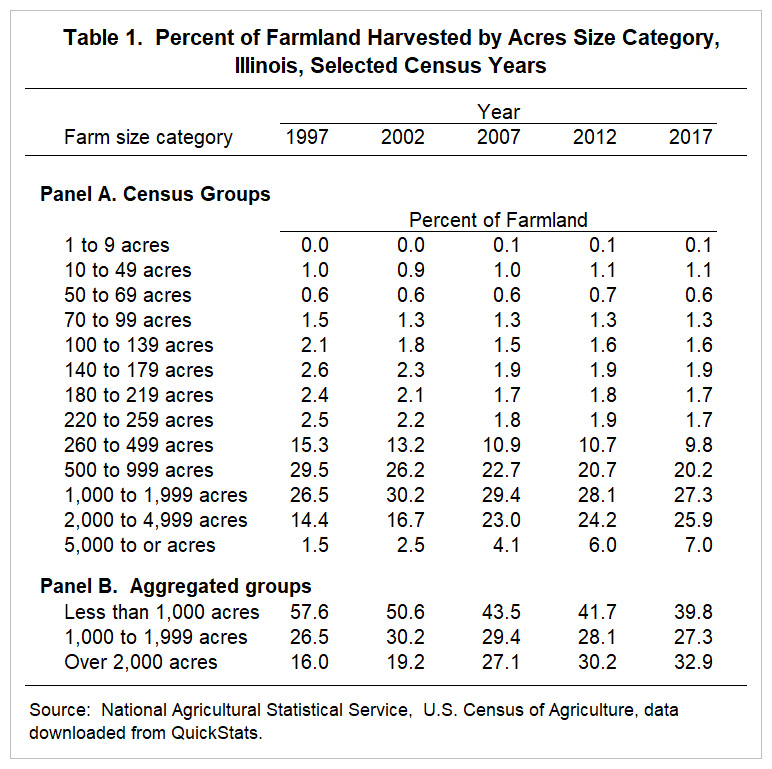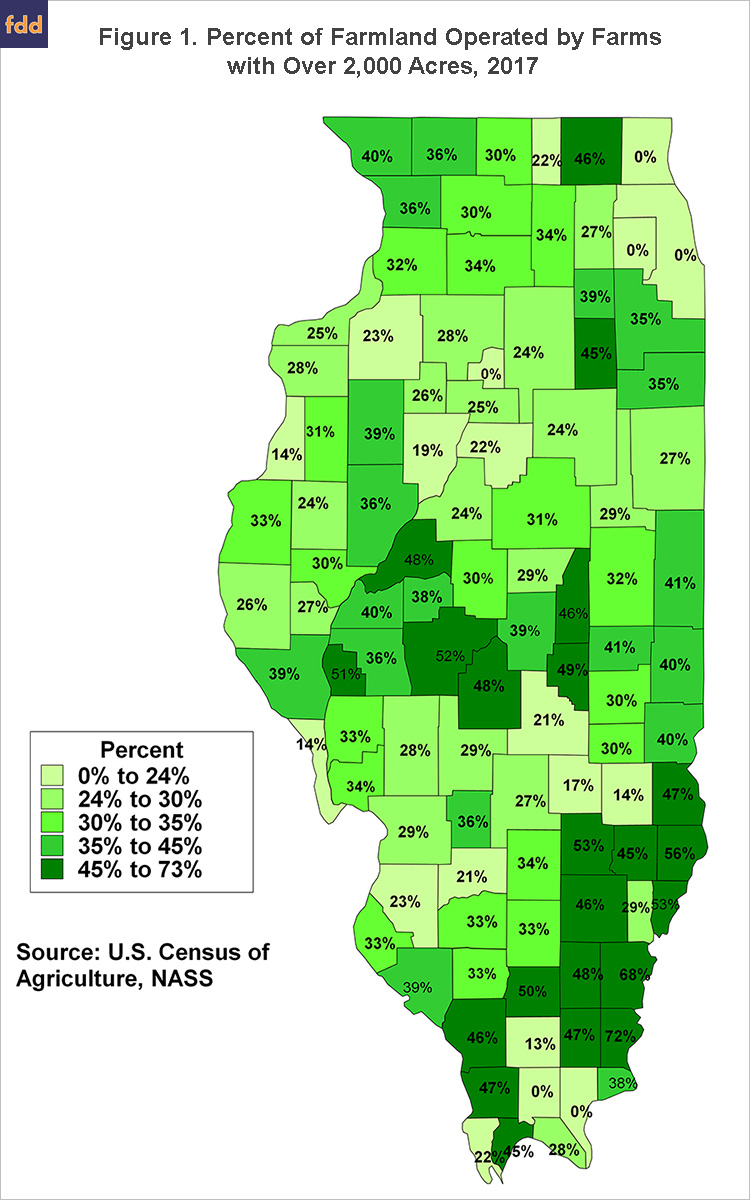Concentration of Illinois Grain Farms
Agricultural census data allows tracking of acres operated by farms of different sizes. We use this data to track grain farm concentration over time. Acres operated by farms with over 2,000 acres has risen from 16.0 percent of Illinois acres in 1997 to 32.9 percent in 2017. Unless some unforeseen event changes agriculture, the trend of higher acres operated by larger farmers will continue. The geography of concentration varies across Illinois counties.
Census Data on Farm Size
Table 1 contains the percent of harvested acres by farm size category. Data come from the U.S. Census of Agriculture and are available from the National Agricultural Statistical Service (NASS) through the Quick Stats website. Data are available for each census year from 1997 to the present. Census years are five years apart.

There are two panels in Table 1. Panel A shows percent of acres operated by different farm sizes in groups that come from NASS. These percentages are summarized into three groups in Panel B:
- Less than 1,000 acres includes all size categories below 1,000 acres in Panel A.
- 1,000 to 1,999 acres is the same category from Panel A.
- Over 2,000 acres is the sum of the 2,000 to 4,999 and over 5,000 acre categories in Panel A.
The focus in the remainder of this article will be on values in Panel B.
Growth in Concentration over Time
In 2017, 39.8 percent of farmland in Illinois was operated by farms of less than 1,000 acres (see the final column in Panel B, Table 1). Farms with from 1,000 to 1,999 acres farmed 27.3% of the acres, and farm with over 2,000 acres farmed 32.9% of acres. The sum of the three categories for each year equals 100 percent.
Three trends are evident in Panel B of Table 1. First, farms with less than 1,000 acres are losing control of Illinois farmland, going from 57.6 percent in 1997 to 39.8 percent in 2017. Declines occurred in each census year. From 1997 to 2017, farms with less than 1,000 acres decreased farming percentage by 18 percentage points (57.6 percent in 1997 – 39.8 percent in 2017).
Second, farms in the 1,000 to 1,999 remained roughly stable in terms of percent of acres farmed, with an increase from 1997 to 2002, and then a decline after that. From 1997 to 2002, acres farmed increased from 26.5 percent to 30.2 percent. Then, the percentage declined each census year to 27.3 percent in 2017. In terms of percent operated, farms from 1,000 to 1,999 acres are roughly in the same position in 2017 as in 1997, but with a decreasing trend since 2002.
Third, farms with over 2,000 acres grew in acres operated. In 1997, farms with over 2,000 acres operated 16.0 percent of acres farmed in Illinois. In 2017, the percentage grew to 32.9 percent. An increase of about 3 percent occurred in each five-year period between censuses.
Concentration by County
Figure 1 shows the percent of acres operated by farms with over 2,000 acres by Illinois county in 2017. There is a considerable range across Illinois counties. The three highest percentages are in southern Illinois: Gallatin with 72%, White with 68%, and Lawrence with 56%. There are size counties that the census indicates that there are 0 percent farmed by over 2,000 acre farms: Cook, DuPage, Johnson, Lake, Pope, and Putnam. These 0 percent counties have limited agricultural farmland.

In most of Illinois, the percentage of land operated by farms over 2,000 acres is less than 40% (see Figure 1. There are several notable exceptions. In northern Illinois, McHenry and Grundy Counties have over 45% of the farmland operated by farms with over 2000 acre. In central Illinois, there are several counties with over 40% of acres operated by 2,000 plus acre farms: Sangamon (52%), Scott (51%), Moultrie (49%), Christian (48%), Mason (48%), and Piatt (46%). Many counties in south east and southern Illinois have over 40% of land farmed by 2,000 plus acre farms.
Summary and Commentary
As is well known, the percent of acres operated by larger farms has grown over time, with most of the acres coming from farms with less than 500 acres. One would expect those trends to continue. Even without any introductions of new technologies, there are powerful forces at work leading to increasing farm size. An increase to 36% of farmland operated by 2,000 plus acre farms should be expected in the 2022 census.
Perhaps surprisingly, the levels of concentration are uneven across Illinois. There are areas with higher concentration, particularly in central and southern Illinois. Overall, local market conditions likely play a significant role in acres operated by different farm sizes.
Disclaimer: We request all readers, electronic media and others follow our citation guidelines when re-posting articles from farmdoc daily. Guidelines are available here. The farmdoc daily website falls under University of Illinois copyright and intellectual property rights. For a detailed statement, please see the University of Illinois Copyright Information and Policies here.







